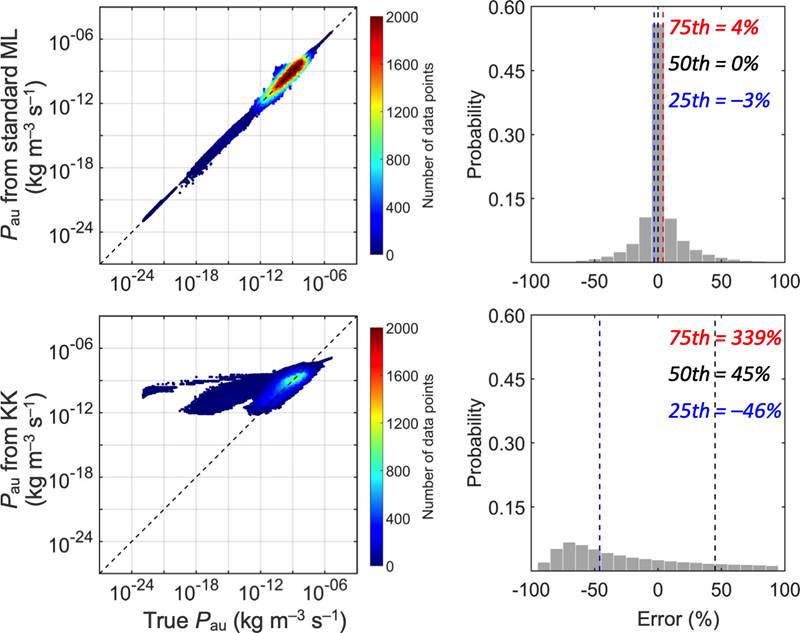Rain formation and amount is important to get right in climate models. Many climate models produce light rain (or drizzle) too frequently in warm, low-level clouds over the ocean. Warm rain can form when water drops collide and combine within clouds. This is an extremely complex process, so scientists simplify it for climate models using a mathematical method called parameterization. These methods create a bulk estimate of how fast and how many cloud drops will collide with each other or with larger particles to form drizzle and rain. This research used data collected in the field along with machine learning to create new methods to estimate drizzle and warm rain formation.
The new methods significantly outperform current methods in terms of how precisely they model drizzle formation without excess computer time. The related research found that the rate at which drizzle forms from collisions between cloud droplets is related to drizzle drop number concentration (the total number of drizzle drops present in any given volume of air). This was a surprising result as the likelihood that two cloud drops will collide to form a new drizzle particle is not directly related to how many drizzle particles currently exist in the cloud. However, the drizzle drop number concentration provides information on the stage of evolution of clouds as drizzle forms. If a cloud has more drizzle drops it is also more likely to have a wide range of cloud drop sizes, which makes collision of those drops more likely as the air motions in clouds move the cloud drops around. Incorporating this factor into models improves how well the models predict drizzle formation.
The collision-coalescence of water drops in air is a fundamental growth process of warm rain. Precipitation can form via the autoconversion process with coalescences between cloud droplets or via the accretion process with coalescences between cloud droplet and rain drop. Scientists need improved understanding of the rate of these processes to determine the onset of precipitation and predict precipitation amount, frequency, and susceptibility to aerosols. Using aircraft cloud probe measurements collected from the Aerosol and Cloud Experiments in the Eastern North Atlantic (ACE-ENA) field campaign at the Atmospheric Radiation Measurement Department of Energy user facility, researchers from Colorado State University, the University of Reading, the National Oceanic and Atmospheric Administration Earth System Research Laboratory, the University of Washington, the University of Quebec at Montreal, Pacific Northwest National Laboratory, and Washington University in Saint Louis provided new insights and new parameterizations for these processes.
The researchers built machine learning models to predict autoconversion and accretion rates from cloud and drizzle properties, using measurements from the ACE-ENA campaign in the Azores and the stochastic collection equation. The uncertainty in the new estimates of autoconversion and accretion rates are about 15 percent and 5 percent, respectively. The results confirm that cloud and drizzle water content are the most important factors for determining accretion rates. For autoconversion, they also discovered a robust dependence on drizzle number concentration. This finding is unexpected, because the autoconversion process represents the coalescence between cloud droplets and is causally only related to cloud properties. However, drizzle number concentration does contain information on the width and evolution of the cloud droplet size distribution, and hence indirectly on the autoconversion rate. By using simple collection kernels, the researchers replicate this dependence in theoretical derivations. This implies that the relation between autoconversion rate and drizzle number concentration is real and should be considered in the parameterizations.
Sally McFarlane
Program Manager
Department of Energy Office of Science, Biological and Environmental Research
sally.mcfarlane@science.doe.gov
J.-Y. Christine Chiu
Principal Investigator
Colorado State University
Christine.Chiu@colostate.edu
This research was supported by the Department of Energy Office of Science, Biological and Environmental Research. One of the researchers was supported by the European Research Council.
Chiu, J., et al., Observational Constraints on Warm Cloud Microphysical Processes Using Machine Learning and Optimization Techniques. Geophysical Research Letters, 48, e2020GL091236 (2021). [DOI: 10.1029/2020GL091236].
Scraped from https://ww.sourcearu.com/doe/article/how-does-drizzle-form-machine-learning-improves-models-these-processes/
